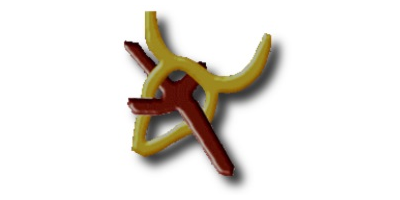
About Mr. Benner's Logo
By Jeff A. BennerThe most common word in the Hebrew Bible is the word את (et). The first letter is the א, called an aleph, and is the first letter of the Hebrew alephbet. The second letter in the word את (et) is the ת, called a tav, and is the last letter of the Hebrew alephbet. These two letters are the "first and the last," the "beginning and the end" and the "Aleph and the Tav" (which is translated as "the alpha and the omega," the first and last letters of the Greek alphabet, in the book of Revelation). In the Hebrew language, the word את (et) is used as a noun and as a preposition.
Beat your plowshares into swords, and your pruning hooks into spears; let the weak say, "I am a
warrior."
(Joel 4:10; 3:10 in Christian Bibles)
The word "plowshares," in the passage above, is the Hebrew noun את (et), which appears in the Hebrew bible five times. A plowshare is the metal point of the plow which digs into the soil creating a furrow for planting seeds. When we examine the original pictographic script used in ancient times to write Hebrew, we can see a clear connection between the letters of this word and its meaning. The modern Hebrew form of the letter aleph is א, but is an evolved form of the original pictograph  , a picture of an ox head. The ancient pictographic form of the letter ת is
, a picture of an ox head. The ancient pictographic form of the letter ת is  , a picture of two crossed sticks which are used as a marker. When these two pictographs are combined, we have the meaning "an ox toward the mark." Fields were plowed with a plow pulled behind an ox (or pair of oxen). In order to keep the furrows straight the driver of the ox would aim toward a mark, such as a tree or rock outcropping in the far distance. As we can see, this meaning of driving the ox toward a mark, can be seen in the letters of the Hebrew word את (et).
, a picture of two crossed sticks which are used as a marker. When these two pictographs are combined, we have the meaning "an ox toward the mark." Fields were plowed with a plow pulled behind an ox (or pair of oxen). In order to keep the furrows straight the driver of the ox would aim toward a mark, such as a tree or rock outcropping in the far distance. As we can see, this meaning of driving the ox toward a mark, can be seen in the letters of the Hebrew word את (et).
The word את is also used as a preposition very frequently (over 7,000 times) in the Hebrew bible and first appears in the very first verse of the Bible.
Because the preposition את has no equivalent in the English language, it is not translated, but to demonstrate its meaning in this verse I will translate Genesis 1:1 into English, but retain the word את in its correct position.
The word את is used as a grammatical tool to identify the definite object of the verb. In the example of Genesis 1:1 the verb is the Hebrew word ברא (bara), meaning "to fill," and the definite objects, the ones receiving the action of the verb, are the sky and the land and therefore the word את will precede these words. Just as the "ox" moved toward the "mark" when plowing, the word את (the plowshare) plows the path from the verb of a sentence (the ox) to the definite object (the mark).
Just as the phrase "heaven and earth" is an idiomatic expression meaning "all of creation," the phrase "aleph and tav" is an idiomatic expression meaning "the whole of the alephbet." It is Mr. Benner's mission to search out the history and meanings of the Hebrew alephbet, as well as the roots and words which are created out of them.


